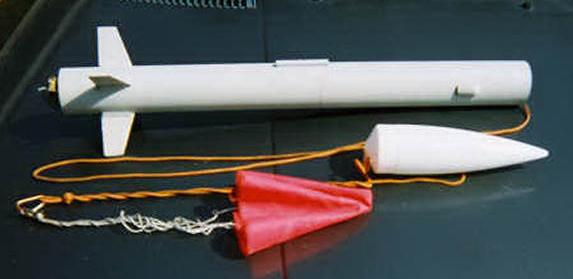| Diameter: | 2.60 inches |
| Manufacturer: | The Launch Pad  |
| Skill Level: | 3 |
| Style: | Scale |
Construction: The other changes I made for sport flying (see photo) are the following: Finishing: Construction Rating: 4 out of 5 On the third flight, only one D12-7 lit, and the climb was still so straight that I didn't realize immediately that something was wrong. Acceleration was slower, with a slight wobble, with apogee at about 350-400'. ASRAAM wallowed on its side momentarily, and descended in a slow flat spin, with chute ejection at a good 150' off the ground. So even with long delay D12-7's, a safe recovery occurs if one engine fails to ignite. This is the mark of a good cluster design. I expect a similar happy result would be less likely with E9 power, so I've stuck with D12's. Recovery: Flight Rating: 5 out of 5 Summary: Overall Rating: 4 out of 5 Brief:
Brief:
ASRAAM is a scale kit by The Launch Pad that models a prototype of a thrust-vectored air-to-air missile. As such, it sports a set of dinky fins that suggest not too much of a stability margin. In fact, ASRAAM is not only exceptionally stable in flight, but is an excellent, easy-building sport flyer, and a good choice for a first cluster model (it uses a pair of 24mm motors). Surprisingly, flight is acceptable with only a single D12 firing, and this further recommends ASRAAM as a "starter" cluster model.
The model construction is straight-forward, 4FNC. I decided from to outset to build it as a sport-flyer rather than scale, so I made a number of changes, the main one being to extend the 24 mm motor tubes to accommodate a pair of E9-6's or (with a spacer) the intended D12's. Because of the added weight of the former, I determined that 35g nose weight would be needed when E9's are flown. In the event, I found ASRAAM to fly so well on D12-7's that I haven't gotten around to trying the E9's. Simulation indicates an altitude of 1200-1300' on E9-6's.
Since this was a sport model, I finished it simply with one coat of flat gray aircraft primer, after coating the fins with balsa sealer. Flight:
Flight:
Thus far, I have flown ASRAAM exclusively on Estes D12-7's. This is not the delay recommended by the manufacturer, but that is what I have used, and ejection is right at apogee, about 700' or so.
For our island launch site, we tend to use the smallest chute possible, but even with the 14" LOC system, no damage has occurred on landing.
In summary, this is a great flying kit, contrary to what its odd appearance (the dinky fins) might suggest. All the parts are there and work, and the the changes I made were really done with an eye toward sport flying vs. scale. Performance is outstanding, especially on a single motor. My recommendation for power is the D12-7, at least with the modifications I made.
Other Reviews
- The Launch Pad ASRAAM By Joe Cacciatore (June 1, 2011)
Brief: Dual "D" engine scale model of the UK/Germany Advanced Short Range Air to Air Missile (ASRAAM). This Launch Pad rocket is exactly like all the other TLP kits. The Kit contains: Plastic nose cone Cardboard body tubes (2) Balsa fins Shock cord attachment & engine mounting the same as the older Estes rockets. Parachute is purple mylar. The quality of the parts ...
 |
 |
Flights
Sponsored Ads
 |
 |











